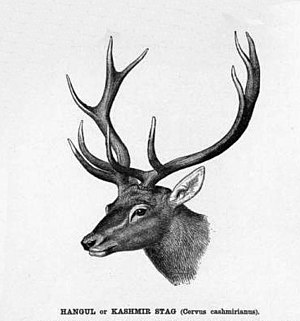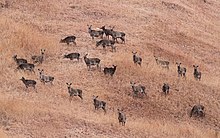Cashmere deer
| Cashmere deer | ||||||||||||
|---|---|---|---|---|---|---|---|---|---|---|---|---|

Head of a hangul |
||||||||||||
| Systematics | ||||||||||||
|
||||||||||||
| Scientific name | ||||||||||||
| Cervus hanglu hanglu | ||||||||||||
| Wagner , 1844 |
The Kashmiri deer or hangul ( Cervus hanglu hanglu ) is a subspecies of the Chinese red deer ( Cervus hanglu ) from the genus of the noble deer ( Cervus ) in Asia.
description
The Hangul reaches a head-torso length of 210 to 230 cm and a shoulder height of 120 to 130 cm. The fur is brown to ash-brown, lighter on the flanks and limbs. In summer the fur is lighter and more reddish. The head is long with a narrow muzzle, lips, ears and chin are whitish. The antlers have eye, ice, middle rungs and crown, in the adult animal five or more ends per pole. The neck is long and bushy hairy in the males. The tail is relatively short and lighter on the underside. The mirror is framed in white and dark.
distribution
The distribution area of the Hangul is in Kashmir as well as in northern Chamba , the largest population lives in the Dachigam National Park , which is established in the North Indian Union Territory of Jammu and Kashmir .
Systematics
|
Internal systematics of red deer according to Meiri et al. 2018
|
The Kashmiri deer is a subspecies of the Chinese red deer ( Cervus hanglu ) from the genus of the noble deer ( Cervus ). The Chinese red deer in turn contains the Jarken deer ( Cervus hanglu yarkandensis ) and the Buchara deer ( Cervus hanglu bactrianus ) as further subspecies . Originally, the Hangul was considered more closely related to the Asian elk due to its exterior . Partly it was therefore together with the Tibetan red deer ( Cervus wallichii ) and the Szetschuan deer ( Cervus macneilli ) as belonging to a separate species, for which the German common name "China red deer" was proposed in 2011, the scientific name was due to the Name priority Cervus wallichii . In a revision of the deer in 2011, however, the Kashmiri deer were recognized as independent and viewed as possibly closer to the western red deer ( Cervus elaphus group). A genetic study from 2015 put the Hangul in direct relation to the Bukhara deer and the Jarken deer, both of which were originally designated as subspecies of the red deer. The genetic data, which could be reproduced in another study from 2018, supported the closer relationship with the western red deer than with the wapitis, which is more widespread to the east, as identified by Groves and Grubb in 2011. Within the western red deer group, both the Kashmiri and the Bukhara and Jarken deer occupy a basic position, which, in the opinion of the authors, supports a classification into a separate, common species. For reasons of naming priority, it has the scientific name Cervus hanglu . In 2020, “China red deer” was postulated as a common German name for this common species.
threat

The Hangul is considered endangered. While the population in the early 90s of the twentieth century was 3,000–5,000 animals, at the end of 2007 the population was estimated at only 190 animals. The main reasons for the decline are the destruction of the habitat and hunting. The Hangul was declared a state animal of the Indian state of Jammu and Kashmir on May 11, 1987 .
Individual evidence
- ↑ a b Meirav Meiri, Pavel Kosintsev, Keziah Conroy, Shai Meiri, Ian Barnes and Adrian Lister: Subspecies dynamics in space and time: A study of the complex reddeer using ancient and modern DNA andmorphology. Journal of Biogeography 45, 2018, pp. 367-380, doi: 10.1111 / jbi.13124
- ^ S. Mattioli: Family Cervidae (Deer). In: DE Wilson and RA Mittermeier (eds.): Handbook of the Mammals of the World. Volume 2: Hooved Mammals. Lynx Edicions, 2011, pp. 350-443 ISBN 978-84-96553-77-4
- ↑ Colin Groves and Peter Grubb: Ungulate Taxonomy. Johns Hopkins University Press, 2011, pp. 1–317 (SS 71–107)
- ↑ Rita Lorenzini and Luisa Garofalo: Insights into the evolutionary history of Cervus (Cervidae, tribe Cervini) based on Bayesian analysis of mitochondrial marker sequences, with first indications for a new species. Journal of Zoological Systematics and Evolutionary Research 53 (4), 2015, pp. 340-349, doi: 10.1111 / jzs.12104
- ↑ Connor J. Burgin, Don E. Wilson, Russell A. Mittermeier, Anthony B. Rylands, Thomas E. Lacher and Wes Sechrest (Eds.): Illustrated Checklist of the Mammals of the World. Lynx Edicions, 2020, p. 314
- ↑ Cervus elaphus in the endangered Red List species the IUCN 2006. Posted by: Deer Specialist Group, 1996. Accessed on 28/08/2007.
- ↑ Kashmiri Hangul faces extinction threat
- ↑ Official website of the state of Jammu and Kashmir ( Memento of the original from February 1, 2008 in the Internet Archive ) Info: The archive link has been inserted automatically and has not yet been checked. Please check the original and archive link according to the instructions and then remove this notice.